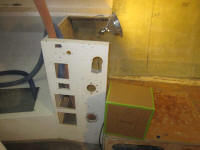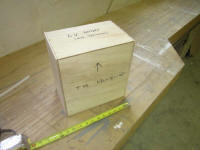
110 Cookson Lane | Whitefield, ME 04353 | 207-232-7600 | tim@lackeysailing.com
Sidebar: Exploratory Measurement/Planning Work for Possible Electric Motor Installation
The only real space constraint for the installation of an electric propulsion motor, of course, is the battery bank required. Logic and common sense dictates that this bank must be of a significant size to achieve a usable, practicable range; therefore, for the purposes of this exercise, I specified four pair of Trojan T-105 6V lead-acid batteries, or compatible: eight batteries total, for an approximate reserve capacity of 800 amp-hours (usable capacity about 400 amp- hours). This is almost 500 lb. of batteries.
This capacity seems consistent with most installation and planning guidance available on the subject, and provides more capacity than certain electric motor websites would suggest, as I felt that some recommended capacities were simply too marginal for the proposed installation and realistic usage requirements--all of this being the only real downside to an electric propulsion system.
In this case, only an even number of battery pairs (i.e. two pair or four pair, but not three) makes sense, as the battery weight needs to be evenly distributed between both sides of the vessel, since there's nowhere with sufficient room (or otherwise suitable) to place these batteries on the centerline.
The central location of the engine room dictates that the batteries be nearby, so the most logical starting point for battery placement was the space beneath the adjacent port settee, and its counterpart to starboard. I used a simple plywood mockup to represent the overall battery size, including terminal height, and if anything the mockup was a bit oversize to provide a bit of leeway.
Starting on the port side next to the engine, I simulated how four of these batteries would fit. At the forward end, with the battery oriented with long dimension in an athwartships manner, there was just enough room for the battery height beneath the existing level of the settee, though the requirement for a support platform would ultimately raise the height a bit.
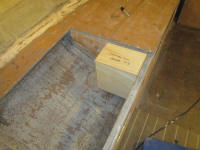
Continuing aft, the shape of the hull eventually caused the fourth battery (the last required on this side) to stand up well above the current level of the settee.

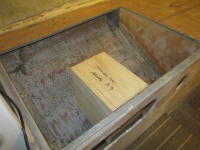

Turning the batteries 90° allowed the battery at the aft end to remain below the height of the settee, but there was only room for two batteries to fit this way, plus (perhaps) one oriented the other direction. This meant that the last battery would have to go in the next compartment forward, where there would be room for it without issue. The current opening to this space was too small to allow passage of my mockup, but measurements suggested it would fit once inside. So the potential for battery stowage on the port side appeared possible without any major changes, though storing all four batteries in the after half of the space--which seemed ideal--would require raising the height of the platform slightly, and moving batteries into the forward half of the space would require new access hatches.
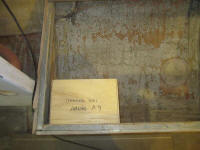
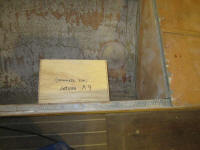
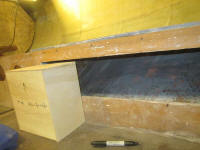
On the starboard side, however, the situation was worse. None of batteries would fit beneath the current settee level when turned with the long dimension athwartships, and the shape of the hull here--and the fact that this settee started further outboard than the other, with a resultant loss of space--wouldn't allow all four batteries to fit in the space regardless of orientation: even turned the other way, only two batteries would fit before the shape of the space pushed the height above the current settee level. Raising the platform would help, but it'd have to be much higher to fit all four batteries.
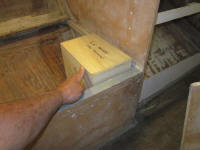
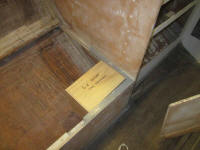
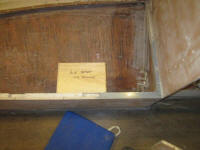
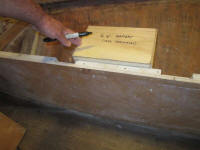
There was additional potential battery space in the galley itself, just aft, with no headroom problems. Whether this is a good space for this use depends on other things, I suppose, but it's certainly possible to locate two batteries here.

Summary
The eight, 6V batteries (my opinion of a practical minimum) required for the electric motor propulsion system (as well as general shipboard power requirements) would fit in a generally evenly-distributed way, though certain changes to the affected cabinets might be required to properly fit them given how tight the clearances are. Keeping the batteries close to the engine room, as well as to the center of gravity of the boat, eliminated other locations from realistic consideration. Creating cable runs between both possible storage areas would likely raise various issues, but ought to be possible.
One way to eliminate some of the range and recharging issues associated with electric propulsion systems is to keep an auxiliary AC generator on board. As requested, I looked into the possible locations where such a generator could be stored when not in use. I used the Honda EU2000i (2KW) for this scenario. At about 20" x 11.5" by 16.5", this generator would fit through the starboard cockpit locker opening, with plenty of room inside the locker, though this stowage would take up a significant amount of the available space within.
The only other potential storage areas for this unit would be accessible only from the cabin, through the quarterberth: the area directly beneath the cockpit, where the fuel tank used to be, and possibly the so-called "wet locker" directly aft of the companionway ladder: these spaces were large enough to hold the generator. Whether these would make good storage spaces for the auxiliary generator is another question.
Gasoline required to run this generator could only be stored in jugs on deck, as it's unsafe to store portable jugs anywhere in an enclosed space. A permanently installed, belowdecks tank with some sort of transfer system could be another option, albeit with additional complication.

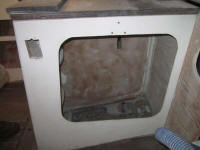
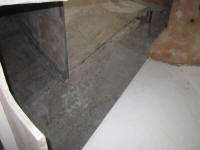
Sidebar: Sardine Woodstove Possible Locations
Should the electric propulsion system come to be, it could eliminate other fuel sources on board, leading the owner (along with the undeniable charm and romance of the unit) to consider a Sardine wood stove as a cabin heat source.
The size of this little stove poses no problem, but the required heat shielding and space from combustible materials makes the overall space required to fit the stove much more difficult to achieve without considering more significant changes to the interior layout to accommodate it.
The most logical location is near the base of the main bulkhead. Even here, the exhaust stack would have to angle to port to avoid interference with the mast (located just forward of this bulkhead), which complicates this particular installation location. The stove could either be angled in the corner here, or parallel to the bulkhead. Using this location would prohibit installation of a cabin table there.
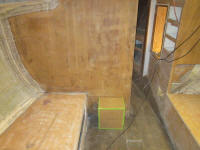
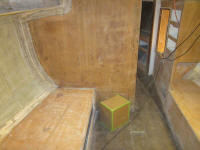
It could probably be made to work (i.e. feasible) against the forward side of the starboard galley bulkhead. This would impact the utility of the settee and make it unusable for sleeping. There wasn't much I liked about this location, but it was theoretically possible.
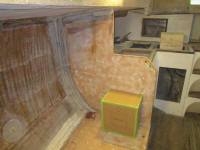
A final possibility could be in the now-open space beneath the nav station, just aft of the port settee (picture the "stove" in place of that bulkhead to its left). This would require cutting away the short longitudinal bulkhead (currently peppered with old holes and needing rebuilding anyway), and would also impact use of this space as a nav station proper. But the stove pipe would have a straight run, though this exit point would affect any plans for a cockpit dodger, and the location wouldn't overly affect use of the settee. The hot stovepipe running through such a central location, and so near to the companionway, could pose some issues.
